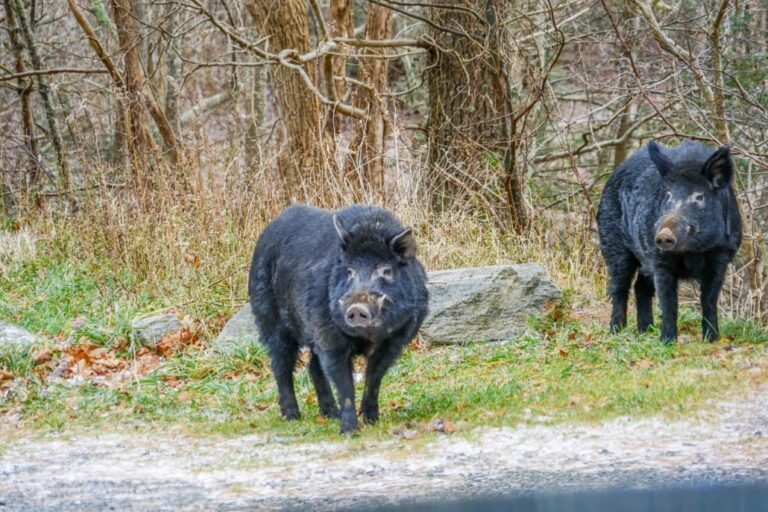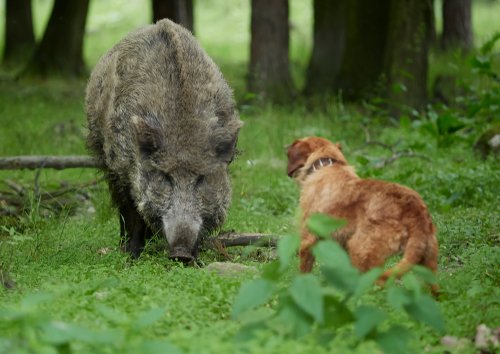Kansas Hog Hunting Adventures – What You Need to Know
When you think of Kansas, you might conjure images of vast fields, friendly people, and perhaps even tornadoes. But did you know that hog hunting is also a beloved pastime in the Sunflower State? In this blog we will review Kansas hog hunting in detail.
Yes, my friend, Kansas’s rolling hills and fertile plains provide the perfect backdrop for an exhilarating hog-hunting adventure. For many Kansans, hog hunting is more than just a sport; it’s a way of life.
The thrill of the chase, the camaraderie with fellow hunters, and the satisfaction of bringing down these formidable creatures make it an experience like no other. Whether you’re an experienced hunter or just starting your wild game journey, hog hunting in Kansas promises excitement and adventure at every turn.
Importance of hog population control in the state
While we appreciate all animals and their place in nature’s grand tapestry, it’s important to understand why controlling hog populations has become crucial for our beloved state. You see, feral hogs and Eurasian boars have recklessly invaded our lands. These beasts reproduce astonishingly, wreak havoc on crops and natural habitats, and even endangering native species.
These invasive hogs not only cause significant damage to our environment but also pose a threat to public safety. Their aggressive nature and large size can result in property destruction or even attacks on humans and livestock.
For these reasons, hog population control is urgently necessary for Kansas. So, when you embark on your next thrilling hunt amidst the vast landscapes of Kansas, remember that you are not merely indulging in a thrilling sport; you are contributing to safeguarding our beautiful state from the ecological imbalance caused by these voracious creatures.
Stay tuned for more detailed information on the hog species found in Kansas and our great state’s regulations surrounding hog hunting. Kansas hog hunting is an adventure that requires skills, instincts, and respect for nature.

Understanding Kansas Hog Species
Introduction to the Two Main Hog Species Found in Kansas: Feral Hogs and Eurasian Boars
Regarding hog hunting in Kansas, it’s essential to understand the two main hog species prevalent in the state: feral hogs and Eurasian boars. While they may seem similar at first glance, these species have distinct characteristics that set them apart.
Feral hogs, also known as wild pigs or wild hogs, are descendants of domesticated pigs that have escaped or been released into the wild. They are highly adaptable creatures and thrive in various habitats, including forests, swamps, and agricultural areas.
Feral hogs typically have longer snouts and straighter tusks than their Eurasian boar counterparts. On the other hand, Eurasian boars are an invasive species originally from Europe and Asia.
These beasts possess a more robust build with a prominent shoulder hump and curved tusks that can grow long. They tend to be more aggressive and territorial than feral hogs due to their instinct for survival in harsher environments.
Physical Characteristics and Behavioral Traits of Each Species
Feral hogs exhibit great diversity in terms of physical appearance. Their coat colors range from brown or black to brindle or spotted patterns.
Some individuals might have wiry hair, while others could be covered with thicker fur. Despite these variations, one consistent feature is their muscular body structure designed for swift movement through different terrains.
Regarding behavior, feral hogs are highly adaptive scavengers with an omnivorous diet consisting of roots, tubers, insects, small mammals, bird eggs—you name it! They’re known for their intelligence and ability to learn from their environment quickly.
This makes them both challenging opponents for hunters and provides opportunities for strategic approaches. On the other hand, Eurasian boars are more solitary by nature and exhibit a hierarchical social structure.
They communicate through vocalizations such as grunts and squeals, which can be heard in the wild during their mating seasons or when defending their territory. These formidable creatures have a keen sense of smell and hearing, making stealthy hunting techniques essential when pursuing them.
Understanding the physical characteristics and behavioral tendencies of feral hogs and Eurasian boars is crucial for any Kansas hog hunter. By recognizing these differences, hunters can adapt their strategies accordingly to increase their chances of success in the field.
Hunting Regulations and Licensing in Kansas
Explanation of the hunting seasons, bag limits, and weapon restrictions for hog hunting in Kansas
Regarding hog hunting in Kansas, it’s important to familiarize yourself with the regulations and licensing requirements. Firstly, let’s talk about the hunting seasons. In Kansas, there is no specific season for hog hunting, as these pesky creatures can wreak havoc on the environment year-round.
This means you have the freedom to pursue them whenever you please. However, some public lands or private properties may have specific rules regarding when hogs can be hunted or if they require special permits.
Now, let’s delve into bag limits. In Kansas, there are no bag limits for hogs!
That’s right; you can harvest as many hogs as you want during your hunt. This is because they are considered an invasive species threatening agriculture and native wildlife.
The state encourages hunters to help control their population by taking down as many as possible. When it comes to weapon restrictions, Kansas provides hunters with flexibility.
You can use rifles, shotguns, muzzleloaders, handguns – any legal firearm is fair game (pun intended). Just ensure you follow all safety regulations and always be mindful of your surroundings.
Overview of the licensing process and requirements for hunters
Now that we’ve covered the exciting stuff like seasons and bag limits let’s focus on licensing requirements for hog-hunting enthusiasts in Kansas. To legally hunt hogs in this state (and any other game species), hunters must obtain a valid hunting license issued by the Kansas Department of Wildlife, Parks & Tourism (KDWPT).
To acquire a license for hog hunts or any other hunting adventure in Kansas, residents will need a resident hunting license. At the same time, non-residents must obtain a non-resident hunting license. These licenses can be purchased online through the KDWPT website or from authorized vendors throughout the state, such as sporting goods stores or bait shops.
It’s worth noting that hunters under 16 are exempt from obtaining a hunting license in Kansas while accompanied by a licensed adult hunter. However, it’s always wise to check with the KDWPT website or contact their office directly to ensure you have the most up-to-date information regarding licensing requirements and any specific rules related to hog hunting in Kansas.
So, ensure you know all the necessary regulations and obtain your hunting license before starting your hog-hunting adventure in Kansas. With that out, let’s move on to some tips and tricks for successful hog hunting!
Best Hunting Locations in Kansas
Top Regions and Counties for Abundant Hog Populations
When it comes to hog hunting in Kansas, there are a few regions and counties that stand out as prime hotspots for encountering these wild creatures. The Flint Hills area is one of the top regions known for abundant hog populations. The expansive grasslands and dense vegetation provide an ideal habitat for hogs to thrive.
Lyon, Chase, and Morris counties within this region consistently offer successful hunting opportunities due to their significant hog populations. Additionally, southeast Kansas boasts some excellent hog hunting grounds.
Bourbon County, Crawford County, and Montgomery County are renowned for their sizable hog populations. These areas contain a variety of habitats, including river bottoms, woodlands, and agricultural fields that attract hogs seeking food sources and shelter.
Ideal Habitats Where Hogs Are Commonly Found
To increase your chances of a successful hunt in Kansas, it’s essential to understand the ideal habitats where hogs tend to frequent. River bottoms are prime locations as they provide easy access to water sources required by hogs for survival. The Marais des Cygnes River Valley in eastern Kansas is particularly well-known for its abundance of feral hogs.
Agricultural areas also attract hogs due to the availability of crops like corn and soybeans that serve as valuable food sources. Fields near wooded areas or water bodies tend to be especially appealing to hogs as they offer cover from predators while allowing easy access to food and water.
When planning your Kansas hog hunting adventure, consider targeting prime regions like Flint Hills or certain counties rich in hog populations, such as Bourbon or Montgomery. By venturing into river bottoms or agricultural areas where hogs commonly reside, you’ll significantly enhance your chances of a successful hunt while immersing yourself in the picturesque landscapes that make Kansas an exceptional hunting destination.
Popular Hunting Techniques and Equipment
Diverse Methods for Kansas Hog Hunting
Regarding hog hunting in Kansas, hunters employ various techniques to increase their chances of success. One commonly used method is spot-and-stalk, where hunters locate hogs through careful observation and then track them on foot. This technique requires a keen eye and the ability to move stealthily through the terrain.
Another popular approach is baiting, where hunters set up feeders or bait piles to attract hogs to a specific location. This method allows hunters to wait in an advantageous position for the hogs to come within range.
Gearing Up for the Hunt
Having the right equipment is crucial to maximize your effectiveness while hog hunting in Kansas. When it comes to firearms, many hunters prefer using rifles chambered in calibers such as .308 or .30-06 due to their power and accuracy at longer distances.
Compound bows with sufficient draw weight are recommended for proper penetration for those who prefer archery. Additionally, carrying a reliable knife is essential for field dressing your harvest.
Regarding clothing and gear, camouflage attire that blends into the natural surroundings is highly recommended. Opting for scent control products can also be beneficial since hogs possess an acute sense of smell that can easily detect human presence if not properly managed.
Utilizing dogs trained specifically for tracking hogs can greatly enhance your chances of success by locating wounded or elusive animals. Understanding and employing these popular hunting techniques and investing in suitable gear can significantly increase your prospects while hog hunting in Kansas.
Safety Considerations for Hog Hunting
Importance of understanding firearm safety rules while hunting hogs
Regarding Kansas hog hunting, safety should always be on your mind. Hogs may seem like big, burly beasts, but they can be surprisingly quick and unpredictable.
That’s why it’s crucial to have a solid understanding of firearm safety rules before heading out into the wild. First and foremost, familiarize yourself with your chosen firearm.
Whether using a rifle, shotgun, or even a bow, ensure you know how to operate it safely and effectively. Always treat your weapon as loaded, and never point it toward anyone or anything you don’t intend to shoot.
Keep your finger off the trigger until you’re ready to take aim and shoot. Wear appropriate eye and ear protection to safeguard against any unforeseen incidents is also a good idea.
Tips on how to avoid potential hazards when dealing with aggressive hogs
While most hogs tend to shy away from humans, there can be instances where they become aggressive or defensive. Kansas hog hunting tips include preparing for such situations and avoiding potential hazards. One important tip is maintaining situational awareness at all times.
Look for signs indicating an agitated hog nearby – like raised hair on their backs or loud grunting sounds. If you encounter an aggressive hog, try not to panic (though that’s easier said than done!).
Stay calm and slowly back away while keeping your eyes on the animal. In some cases, hogs may charge at hunters if they feel threatened or cornered.
If this happens, try creating distance between yourself and the hog by using trees or other objects as barriers. Avoid turning your back on them, as this might encourage them further.
Having a designated companion with you during hog hunts is also a good idea, as they can watch your back and provide assistance if needed. Remember, hogs are formidable creatures, and caution is key when dealing with them in the wild.
So, arm yourself with safety knowledge before diving into the thrilling world of Kansas hog hunting. By understanding firearm safety rules and knowing how to handle aggressive hogs, you’ll be well-equipped to enjoy a safe and exhilarating hunting experience.
Hog Meat: Culinary Delights from Wild GameIntroduction to the deliciousness of wild hog meat as a culinary option
Regarding hog hunting in Kansas, the adventure doesn’t end with the thrill of the chase. One of the most rewarding aspects of hunting these wild beasts is savoring the mouth-watering flavor of their meat.
Wild hog meat offers a unique and delectable taste that can rival even the finest cuts of pork. It’s lean, succulent, and has a distinct flavor that sets it apart from farm-raised pork.
The secret behind this exceptional taste lies in the hogs’ diet and lifestyle. Unlike their domesticated counterparts, wild hogs roam freely in their natural habitats, foraging for nuts, roots, and berries.
This diverse diet gives their meat a rich and robust flavor, often earthy and slightly gamey. The lean nature of wild hog meat also contributes to its tenderness, making it an ideal choice for various culinary creations. Tips on proper field dressing techniques to ensure quality meat
To fully appreciate the incredible taste of wild hog meat, handling and dressing the animal properly after a successful hunt is crucial. Here are some important tips for field dressing hogs: 1. Quick Cooling: After harvesting a wild hog, it’s essential to cool down the carcass as quickly as possible to preserve its freshness.
You can do this by removing the internal organs swiftly and placing bags of ice inside the body cavity. 2. Proper Skinning: Skinning a hog requires careful precision to avoid contaminating the meat with hair or dirt.
Start by making an incision along each leg from hoof to knee or ankle joint; then proceed with skinning while pulling gently but firmly. 3. Removing Scent Glands: Wild hogs have scent glands located near the back legs, and these can release a strong odor that affects the taste of the meat.
Take the time to locate and remove these glands to ensure a cleaner flavor. 4. Butchering: Once field dressed, it’s time to butcher the hog into manageable cuts.
Whether you prefer pork chops, roasts, or sausages, it’s important to have sharp knives and proper cutting techniques to ensure clean cuts and maximize meat yield. By following these field dressing techniques and handling the meat with care, you’ll be rewarded with high-quality wild hog meat that is delicious and a testament to your successful Kansas hog hunting adventure.
Kansas Hog Hunting Conservation Efforts
Highlighting initiatives taken by organizations and state agencies to manage hog populations sustainably
Kansas recognizes the significance of managing hog populations sustainably to protect the ecosystem and agricultural lands. Several organizations and state agencies have implemented various initiatives to effectively control and reduce hog numbers. The Kansas Department of Wildlife, Parks, and Tourism (KDWPT) works closely with landowners, hunters, and other stakeholders to develop comprehensive strategies for hog population management.
They conduct surveys, monitor population trends, and collaborate with researchers to gain insights into hog behaviors and habitats. Additionally, collaborative efforts between the KDWPT and local chapters of conservation groups like the National Wild Turkey Federation (NWTF) have resulted in innovative programs to reduce feral hog impacts.
These initiatives often involve targeted trapping or controlled hunts in areas where hogs cause significant damage. By utilizing these techniques strategically, they can help mitigate negative effects on native wildlife populations while also providing valuable data for ongoing research.
Explanation of how hunters contribute to conservation through reporting data
Hunters are crucial in supporting conservation efforts related to Kansas hog hunting. When hunters participate in hunting activities, they enjoy their sport and contribute valuable data that aids conservation efforts. Hunters are encouraged to report their harvests, providing information on location, numbers taken, sex ratios, and even details about any ear tags or collars observed on harvested hogs.
This reporting system helps authorities understand the distribution of hogs across different regions of Kansas and contributes valuable insights into population dynamics over time. By sharing this information with the KDWPT or other relevant agencies involved in managing feral hog populations, hunters actively participate in ongoing research efforts to understand hog movements, behaviors, habitat preferences, and overall population trends.
Conclusion
Kansas is making significant strides in managing feral hog populations sustainably, thanks to the collaborative efforts of organizations, state agencies, and dedicated hunters. Through innovative initiatives and data-driven approaches, hog hunting in Kansas has become vital for population control and conservation. By reporting their harvests and participating in research programs, hunters actively contribute to ongoing efforts to understand and manage feral hogs effectively.
With each successful hunt, hunters not only enjoy the thrill of the experience but also make a positive impact on preserving native wildlife habitats and protecting valuable agricultural lands. As Kansas continues its commitment to sustainable hog population management, hunters can take pride in their role as stewards of the land while relishing the adventure of Kansas hog hunting.





